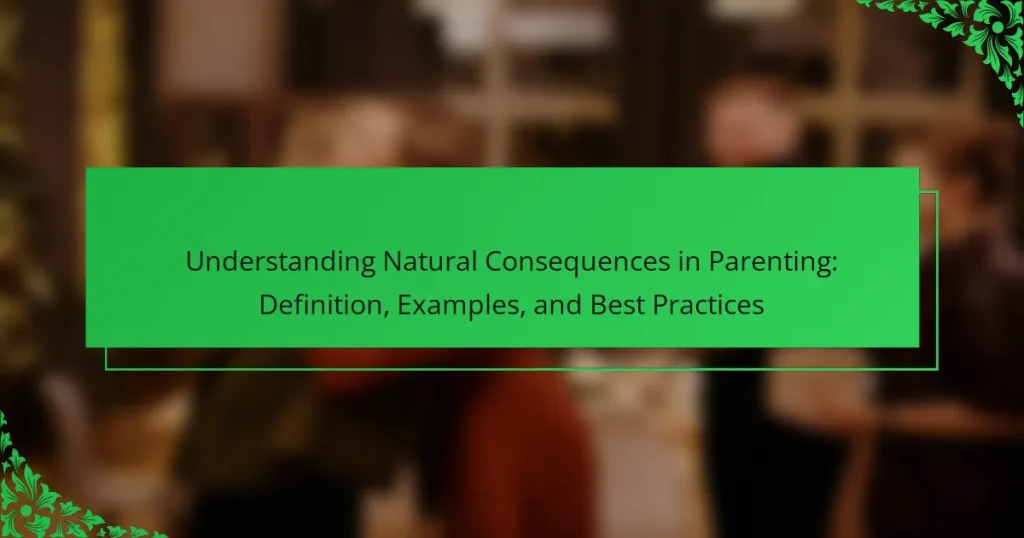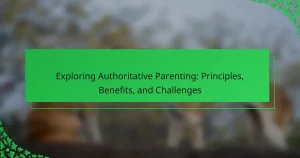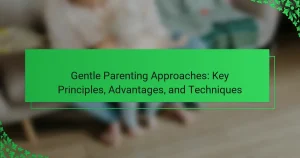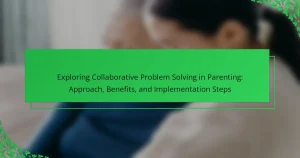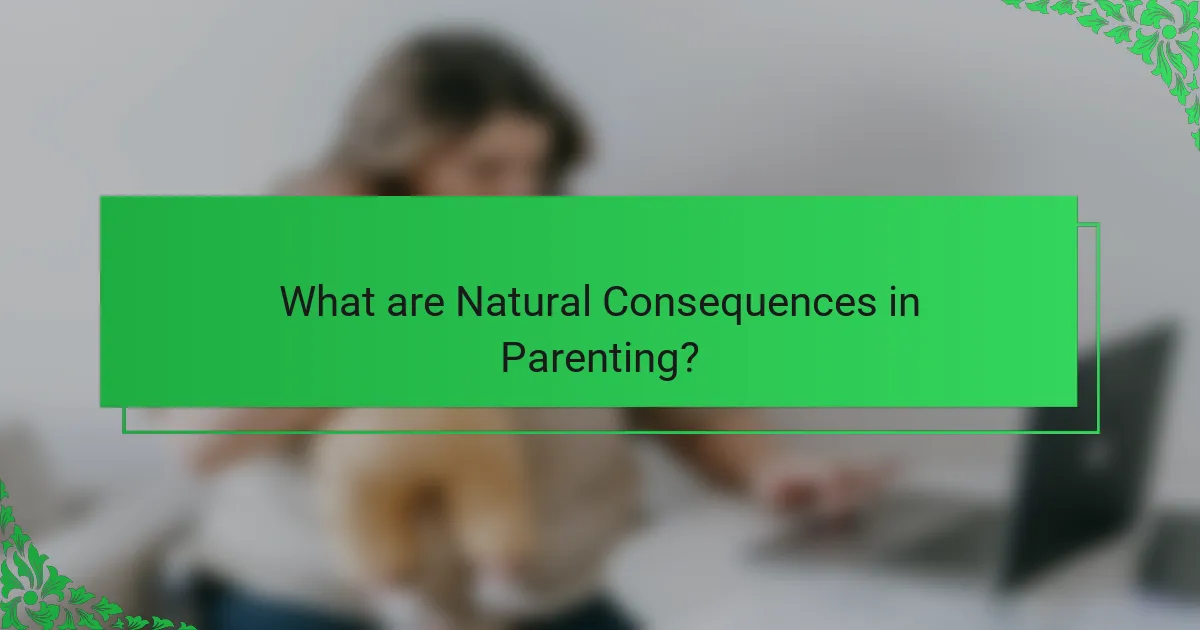
What are Natural Consequences in Parenting?
Natural consequences in parenting are outcomes that naturally occur as a result of a child’s actions. These consequences are not imposed by parents but arise from the child’s behavior. For example, if a child refuses to wear a coat on a cold day, they may feel cold. This teaches them the importance of dressing appropriately. Natural consequences help children learn responsibility and decision-making. Research shows that children who experience natural consequences develop better problem-solving skills. They understand the connection between their actions and the results. This approach fosters independence and critical thinking in children.
How do Natural Consequences differ from Other Parenting Techniques?
Natural consequences differ from other parenting techniques by allowing children to experience the results of their actions without parental intervention. This approach emphasizes learning through real-life outcomes. For instance, if a child refuses to wear a coat on a chilly day, they may feel cold and understand the importance of dressing appropriately. Unlike discipline-based techniques, such as time-outs or rewards, natural consequences are not imposed by parents. They stem directly from the child’s behavior. Research shows that children who learn from natural consequences develop better decision-making skills. This method fosters independence and responsibility, as children recognize the impact of their choices.
What are the key characteristics of Natural Consequences?
Natural consequences are outcomes that occur as a direct result of a person’s actions. They are not imposed by others but arise naturally from behavior. These consequences are often immediate, providing clear feedback. They promote learning and responsibility in children. Natural consequences are typically related to the behavior in question, making the lesson more relevant. They can vary in severity, from minor inconveniences to significant outcomes. Understanding these characteristics helps parents guide their children effectively.
Why are Natural Consequences important in child development?
Natural consequences are important in child development because they teach children about the results of their actions. When children experience the outcomes of their behavior, they learn responsibility. This understanding helps them make better choices in the future. For example, if a child refuses to wear a coat on a cold day, they may feel cold. This real-life experience reinforces the importance of dressing appropriately. Research shows that children who learn from natural consequences tend to become more independent and self-regulating. By facing the results of their choices, they develop critical thinking skills. This process fosters emotional growth and resilience.
What are some common examples of Natural Consequences?
Natural consequences are outcomes that naturally occur as a result of a person’s actions. For example, if a child refuses to wear a coat in cold weather, they may feel cold. Another example is when a child neglects their homework, leading to poor grades. If a child breaks a toy, they will no longer be able to play with it. When a child doesn’t eat dinner, they may feel hungry later. These examples illustrate how natural consequences directly relate to specific actions. They provide valuable lessons without the need for imposed punishments.
How do Natural Consequences manifest in everyday situations?
Natural consequences manifest in everyday situations as direct results of actions taken by individuals. For example, if a child refuses to wear a coat on a cold day, they may feel cold. This immediate feedback teaches them about the importance of appropriate clothing. Another instance occurs when a child neglects their homework, resulting in poor grades. This consequence highlights the value of responsibility in academic settings. Additionally, if a child consistently interrupts others, they may find themselves excluded from group activities. This social consequence reinforces the importance of respectful communication. Each of these scenarios illustrates how natural consequences provide valuable learning experiences in real-life contexts.
What are age-appropriate examples of Natural Consequences?
Age-appropriate examples of natural consequences include a child forgetting their lunch and going hungry at school. This teaches them the importance of remembering their belongings. Another example is a teenager not studying for a test and receiving a poor grade. This highlights the impact of their choices on academic performance. A younger child who refuses to wear a coat on a chilly day will feel cold outside. This experience can encourage them to dress appropriately in the future. These examples illustrate how natural consequences effectively teach responsibility and decision-making skills.

How can parents effectively implement Natural Consequences?
Parents can effectively implement natural consequences by allowing children to experience the results of their actions. This approach encourages accountability and learning. For instance, if a child refuses to wear a jacket on a cold day, they will feel cold and learn the importance of dressing appropriately. Setting clear expectations beforehand is essential. This allows children to understand the consequences of their choices. Parents should also provide guidance and support without rescuing their children from the outcomes. Research shows that children learn better from real-life experiences than from verbal instructions alone. By consistently applying this method, parents foster resilience and decision-making skills in their children.
What steps should parents take to introduce Natural Consequences?
Parents should follow specific steps to introduce natural consequences effectively. First, they need to identify the behavior that requires a consequence. Next, they should allow children to experience the natural outcome of their actions. For instance, if a child refuses to wear a coat, they may feel cold outside. Parents should avoid intervening to let the consequence unfold naturally. It is essential to discuss the experience afterward. This conversation helps children understand the relationship between their choices and the outcomes. Consistency is crucial in applying natural consequences. Regularly allowing children to face the results of their actions reinforces learning.
How can parents communicate the concept of Natural Consequences to their children?
Parents can communicate the concept of natural consequences by using clear, relatable examples. They should explain that natural consequences are outcomes that occur as a direct result of a child’s actions. For instance, if a child refuses to wear a coat on a cold day, they may feel cold. Parents can facilitate discussions about these outcomes after they occur. This helps children understand the connection between their behavior and its results. Parents should encourage children to reflect on their choices and the consequences that follow. Reinforcing this concept helps children learn responsibility. Additionally, using age-appropriate language makes the explanation more effective. Engaging in role-playing scenarios can also illustrate natural consequences in a fun way.
What are some strategies for ensuring consistency in applying Natural Consequences?
Establish clear expectations for behavior. Communicate these expectations consistently to children. Reinforce the connection between actions and natural consequences. Use reminders to help children understand the outcomes of their choices. Be patient and allow time for children to experience consequences. Document instances of natural consequences to track progress. Involve children in discussions about their choices and outcomes. Provide support and guidance to help them learn from experiences.
What challenges might parents face when using Natural Consequences?
Parents may face several challenges when using natural consequences in parenting. One challenge is the unpredictability of outcomes. Natural consequences can vary widely, leading to inconsistent lessons for the child. Another challenge is the emotional response from the child. Children may react negatively, which can be distressing for parents.
Additionally, parents may struggle with timing. It can be difficult to allow a natural consequence to occur at the right moment without intervening. Safety concerns also pose a challenge; parents must balance teaching lessons with ensuring their child’s well-being.
Furthermore, parents might experience social pressure. Others may not understand or agree with the use of natural consequences, leading to feelings of isolation. Lastly, there is the risk of misunderstanding. Parents may misinterpret a child’s behavior or the effectiveness of the consequence, resulting in confusion.
How can parents address resistance from children regarding Natural Consequences?
Parents can address resistance from children regarding natural consequences by clearly explaining the concept. Children need to understand that their actions lead to specific outcomes. Use age-appropriate language to discuss examples of natural consequences. For instance, if a child refuses to wear a coat, they may feel cold outside. Encourage children to reflect on their experiences. Ask them how they feel after facing a natural consequence. This promotes ownership of their choices. Additionally, parents should model acceptance of natural consequences in their own lives. Demonstrating this behavior reinforces the concept. Consistent communication about the importance of natural consequences helps children accept them more readily.
What are common misconceptions about Natural Consequences and how can they be clarified?
Common misconceptions about natural consequences include the belief that they are the same as punishment. Natural consequences arise from a child’s actions without external intervention. They are not designed to inflict pain or discomfort, but rather to teach lessons through real-life experiences. Another misconception is that natural consequences are always immediate. In reality, they can occur over time, such as a child learning the importance of wearing a coat when they feel cold outside. Some parents think that natural consequences are ineffective. However, research shows that children often learn better through experiences than through directives. Clarifying these misconceptions involves educating parents on the distinction between natural consequences and punitive measures. It also requires emphasizing the value of patience in allowing consequences to unfold naturally.

What best practices should parents follow when using Natural Consequences?
Parents should allow natural consequences to occur as a form of learning. This approach teaches children accountability for their actions. Parents must ensure the consequences are safe and age-appropriate. For example, if a child refuses to wear a coat, they may feel cold outside. Parents should avoid rescuing the child from the consequences. This reinforces the lesson that choices have results. Communication is essential; parents should discuss the outcome afterward. Reflecting on the experience helps children understand their decisions. Consistency in applying natural consequences strengthens the learning process.
How can parents create a supportive environment for Natural Consequences?
Parents can create a supportive environment for natural consequences by allowing children to experience the outcomes of their actions. This approach fosters independence and responsibility. Parents should set clear expectations and guidelines for behavior. Consistency in enforcing these guidelines is essential. Open communication allows children to express their feelings about their experiences. Parents can provide guidance without rescuing children from the consequences. Observing and discussing outcomes helps children learn from their mistakes. Research indicates that children who face natural consequences develop better problem-solving skills and resilience. This method supports their emotional and social development.
What role does parental modeling play in the effectiveness of Natural Consequences?
Parental modeling significantly enhances the effectiveness of natural consequences. When parents demonstrate appropriate behaviors, children are more likely to imitate those actions. This imitation reinforces the understanding of cause and effect in real-life situations. For instance, if a parent consistently follows through with natural consequences, children learn the importance of responsibility. Research shows that children who observe their parents modeling accountability are more likely to accept the consequences of their own actions. This modeling creates a framework for children to navigate their choices and learn from their mistakes. Thus, parental modeling is crucial in shaping children’s responses to natural consequences.
How can parents balance Natural Consequences with emotional support?
Parents can balance natural consequences with emotional support by clearly communicating expectations and outcomes. They should explain the natural consequences of actions before allowing children to experience them. This helps children understand the relationship between their choices and results. Simultaneously, parents must provide emotional support during these experiences. Listening to children’s feelings and validating their emotions is crucial. This combination fosters resilience and understanding. Research indicates that children benefit from both experiencing consequences and receiving emotional guidance. For instance, a study published in the Journal of Child Psychology and Psychiatry shows that supportive parenting enhances children’s coping skills. Thus, balancing these aspects leads to healthier emotional development.
What tips can enhance the effectiveness of Natural Consequences in parenting?
To enhance the effectiveness of natural consequences in parenting, parents should allow children to experience the outcomes of their choices. This approach fosters responsibility and accountability. Consistency is crucial; parents must apply natural consequences regularly to reinforce learning. Clear communication about expectations helps children understand the link between their actions and consequences. Parents should remain calm and supportive, guiding children through their experiences without judgment. Additionally, parents can model appropriate responses to consequences in their own lives, demonstrating resilience and learning. Finally, patience is essential, as children may need time to grasp the lessons from natural consequences.
How can parents reflect on their experiences with Natural Consequences to improve their approach?
Parents can reflect on their experiences with natural consequences by analyzing specific situations where they allowed their children to face the outcomes of their actions. This reflection helps identify patterns in behavior and responses. Parents should consider how these consequences affected their child’s learning and decision-making. Evaluating both positive and negative outcomes is crucial. They can ask themselves what worked well and what didn’t. Keeping a journal of these reflections can provide clarity over time. Additionally, discussing these experiences with other parents or professionals can offer new insights. Research shows that children learn effectively from natural consequences, reinforcing the importance of this reflective practice.
What resources are available for parents seeking to learn more about Natural Consequences?
Parents can access various resources to learn about natural consequences. Books such as “The Whole-Brain Child” by Daniel J. Siegel and Tina Payne Bryson provide insights into child development and natural consequences. Online platforms like the American Academy of Pediatrics offer articles and guidelines on parenting strategies. Additionally, parenting workshops and local community centers often provide sessions focused on effective discipline techniques, including natural consequences. Websites like Parenting.com and Psychology Today also feature articles and expert advice on this topic. These resources can enhance parents’ understanding and application of natural consequences in their parenting practices.
Natural consequences in parenting refer to outcomes that naturally arise from a child’s actions, facilitating learning and responsibility without parental intervention. This article explores the definition, key characteristics, and significance of natural consequences in child development, highlighting how they differ from other parenting techniques. It provides practical examples, strategies for implementation, and best practices for parents to effectively guide their children through real-life experiences. Additionally, the article addresses common challenges, misconceptions, and the importance of parental modeling in fostering a supportive environment for learning through natural consequences.
